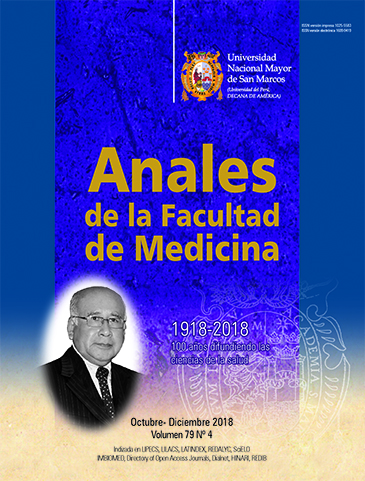Spirometric values in high-altitude overweight population
DOI:
https://doi.org/10.15381/anales.v79i4.15631Keywords:
Spirometry, Reference Values, Altitude, Overweight, PeruAbstract
Introduction: Spirometry is used to evaluate the respiratory function, relating the spirometric values (VE) obtained with predetermined VE. By recommendation, Peru uses the Mexican American population´s equations to obtain their predetermined VE. The population that live in high altitude have higher VE than the predetermined VE. On the other hand, obese people have alteration in respiratory dynamics. In overweight people who live in high altitude, the changes in their VE are unknown, reason that motivated this research. Objective: To Compare the VE obtained in overweight population that live in high altitude with the VE predetermined by the Mexican American population´s equations. Methods: Descriptive, correlational, retrospective study. We present 329 spirometries (239 males and 90 females), with quality grades A and B, performed in an occupational clinic from Huancayo, between February 2017 and January 2018, in overweight people clinically healthy, with ages between 20 to 40 years old. The VE and the body mass index (BMI) were evaluated, then performing the Spearman and Pearson correlation between them. Results: The average VE obtained were greater than 110% of the predetermined average VE. The Pearson correlation between VE and BMI was negative. Conclusions: The overweight population´s VE that live in high altitude are higher than the predetermined VE, with an inverse relation between VE and BMI.Downloads
Published
2018-12-30
Issue
Section
Artículo Original
License
Copyright (c) 2018 Anales de la Facultad de Medicina

This work is licensed under a Creative Commons Attribution-NonCommercial-ShareAlike 4.0 International License.
Those authors who have publications with this magazine accept the following terms:
- Authors will retain their copyrights and guarantee the journal the right of first publication of their work, which will be simultaneously subject to Creative Commons Attribution License that allows third parties to share the work as long as its author and its first publication this magazine are indicated.
- Authors may adopt other non-exclusive licensing agreements for the distribution of the version of the published work (eg, deposit it in an institutional electronic file or publish it in a monographic volume) provided that the initial publication in this magazine is indicated.
- Authors are allowed and recommended to disseminate their work over the Internet (eg: in institutional telematic archives or on their website) before and during the submission process, which It can produce interesting exchanges and increase quotes from the published work. (See El efecto del acceso abierto ).
How to Cite
1.
Córdova Córdova EG, Rojas Palpán FG, Mujica Albán E. Spirometric values in high-altitude overweight population. An Fac med [Internet]. 2018 Dec. 30 [cited 2025 Jun. 2];79(4):288-92. Available from: https://revistasinvestigacion.unmsm.edu.pe/index.php/anales/article/view/15631



